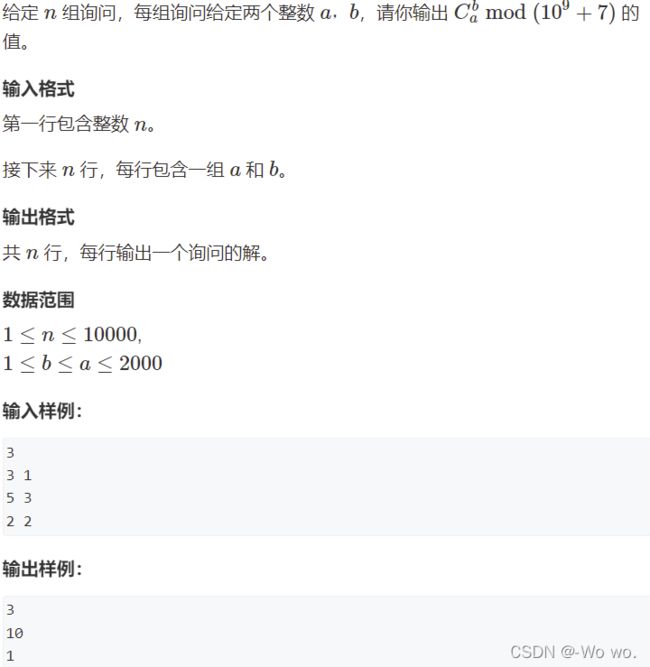【算法竞赛模板】质因子、质数、约数、余数、快速幂(数论大全)
常用数论的算法模板
- 一、质因子
- 二、质数
- 三、约数
-
- ① 试除法求一个数所有约数
- ② 求约数个数
- ③ 求约数和
- ④ 求最大公约数
-
- <1> gcd辗转相除
- <2> 扩展欧几里得
- <3> 反素数
- <4> 同余定理
- <5> 费马小定理(快速幂求逆元)
- 四、余数
- 五、组合数
-
- ① DP求组合数
- ② 逆元求组合数
- ③ 卢卡斯定理求组合数
- ④ 高精度大数求组合数
- 六、快速幂

一、质因子
定义: 指能整除给定正整数的质数
性质: 1没有质因子,每个正整数都能够以唯一的方式表示成它的质因数的乘积
举例: 360 = 2 × 2 × 2 × 3 × 3 × 5 = 23 × 32 × 5,表示成了质因数乘积
时间复杂度: O(logn),最坏为O( n \sqrt{n} n)
算法思想: 从小到大枚举 n 的所有约数,假设枚举较小的那个 p,则 n 中最多只包含一个大于 n \sqrt{n} n 的质因子,如果枚举结束,n 还大于1,那么说明这就是那个大于 n \sqrt{n} n 的质因子,由性质的证明如下图。在筛质数的过程中,用的是欧式线性筛法
例题1: 点这里
例题2: 点这里
/**
* 例题1模板 - while循环下就是对应着它的性质
*/
#include
二、质数
定义: 一个正整数无法被除1和它自身以外的自然数整除则为质数
性质: 任何一个大于1的自然数 n,如果 n 不为质数,那么 n 可以唯一分解成有限个质数的乘积,即 n = P 1 α 1 ⋅ P 2 α 2 ⋅ P 3 α 3 ⋅ ⋅ ⋅ P k α k P_{1}^{α_{1}} · P_{2}^{α_{2}} · P_{3}^{α_{3}} ··· P_{k}^{α_{k}} P1α1⋅P2α2⋅P3α3⋅⋅⋅Pkαk,其中 P 1 < P 2 < ⋅ ⋅ ⋅ < P k P_{1} < P_{2} < ··· < P_{k} P1<P2<⋅⋅⋅<Pk 为质数,像 α 1 、 α 2 α_{1}、α_{2} α1、α2之类的为次数
时间复杂度: 欧式筛法为O(n),埃氏筛法为O(n·logn·logn)
说明: 欧式筛法是线性的,也是我们一般用得较多筛质数的方法。埃氏筛法用的较少,但是它的思路可以用于其他一些题目,思路比较重要
例题: 点这里
/**
* 欧拉线性筛质数
*/
#include
三、约数
定义: 可表示为 N = P 1 α 1 ⋅ P 2 α 2 ⋅ P 3 α 3 ⋅ ⋅ ⋅ P k α k P_{1}^{α_{1}} · P_{2}^{α_{2}} · P_{3}^{α_{3}} ··· P_{k}^{α_{k}} P1α1⋅P2α2⋅P3α3⋅⋅⋅Pkαk,P为质数,使得 a 能被 b 整除,则 b 称为 a 的约数
性质: 点这里参考性质,约数的性质很多都可以用质因数分解表示和解释
提醒: 约数和倍数其实是一对好基友,当求约数的时间复杂度过大时,不妨从它倍数的角度来考虑解决问题
种类:
① 试除法求一个数的所有约数,时间复杂度为 O( n \sqrt{n} n)
② 求约数个数,时间复杂度为 O( n \sqrt{n} n)
③ 求约数之和,时间复杂度为 O( n \sqrt{n} n)
④ 求最大公约数,时间复杂度为 O(logn)
① 试除法求一个数所有约数
#include
② 求约数个数
约数个数为: ( a 1 + 1 ) ⋅ ( a 2 + 1 ) ⋅ ⋅ ⋅ ( a k + 1 ) (a_{1} + 1)·(a_{2} + 1)···(a_{k} + 1) (a1+1)⋅(a2+1)⋅⋅⋅(ak+1)

/**
* 求约数个数
*/
#include Attention: 对于代码中最后判断 x > 1 的举例, 假如 x 为 24,按代码进行下去可知 x = 2 3 × 3 x=2^3×3 x=23×3,所以除了 2 还存在 3 这个质因子
求约数时时间复杂度过大,从倍数关系来考虑的例题 题解: 点这里
例题题目

变种题: 从输入的集合中逐个选取一个数,求剩下的数字有多少个是它的约数
解答代码
#include ③ 求约数和
约数之和为: ( P 1 0 + P 1 1 + P 1 2 + ⋅ ⋅ ⋅ P 2 k ) ⋅ ( P 2 0 + P 2 1 + P 2 2 + ⋅ ⋅ ⋅ P 2 k ) ⋅ ⋅ ⋅ ( P k 0 + P k 1 + P k 2 + ⋅ ⋅ ⋅ P k k ) (P_{1}^0+P_{1}^1+P_{1}^2+ ··· P_{2}^k)·(P_{2}^0+P_{2}^1+P_{2}^2+ ··· P_{2}^k)···(P_{k}^0+P_{k}^1+P_{k}^2+ ··· P_{k}^k) (P10+P11+P12+⋅⋅⋅P2k)⋅(P20+P21+P22+⋅⋅⋅P2k)⋅⋅⋅(Pk0+Pk1+Pk2+⋅⋅⋅Pkk)

/**
* 求约数之和
*/
#include 求约数和(变异)例题:点这里,用区间分块做。
④ 求最大公约数
<1> gcd辗转相除
我们一般用 gcd辗转相除法(欧几里得算法),C++可以用STL自带两条下划线的 __gcd(int num1, int num2),时间复杂度为O(logn)
问题思考:
a) 基本性质是什么?
一个数d,如果能实现 d/a、d/b,那么则会有 d/(a+b)、d/(ax+by)
b) 若是两个数中最大公约数为1,输出的是什么?
输出1
c) 若其中有一个数为0或者两个数为0,又该输出什么?
0与0没有最大公约数,除此之外0与其他数最大公约数为其他数本身
inline int gcd(int a, int b){
return b ? gcd(b, a % b) : a;
}
<2> 扩展欧几里得
定义: 在求得a、b的最大公约数的同时,能找到整数x、y(其中一个很可能是负数),使它们满足贝祖等式 a x + b y = g c d ( a , b ) ax + by = gcd(a, b) ax+by=gcd(a,b),x 和 y 不唯一
算法证明:
gcd(a, b) = d = ax + by,则有 b ⋅ x ′ + ( a m o d b ) ⋅ y ′ = d b·{x}' + (a\space \space mod\space \space b)·{y}' = d b⋅x′+(a mod b)⋅y′=d
a m o d b = a − [ a b ] ⋅ b a\space \space mod \space \space b = a - [\frac{a}{b} ]·b a mod b=a−[ba]⋅b
b ⋅ x ′ + ( a − [ a b ] b ) ⋅ y ′ = d b·{x}' + (a - [\frac{a}{b} ]b)·{y}' = d b⋅x′+(a−[ba]b)⋅y′=d
移项得 a ⋅ y ′ + b ( x ′ − [ a b ] y ′ ) ⋅ = d a·{y}' + b({x}' - [\frac{a}{b} ]{y}')· = d a⋅y′+b(x′−[ba]y′)⋅=d
所以有 { x = y ′ y = x ′ − [ a b ] y ′ \left\{\begin{matrix} x = {y}'\\y = {x}' - [\frac{a}{b} ]{y}'\end{matrix}\right. {x=y′y=x′−[ba]y′
当我们在计算exgcd的时候(如下代码),将x和y翻转一下,便能更好的计算
则有: a ⋅ x ′ + b ( y ′ − [ a b ] x ′ ) ⋅ = d a·{x}' + b({y}' - [\frac{a}{b} ]{x}')· = d a⋅x′+b(y′−[ba]x′)⋅=d
所以有 { x = x ′ y = y ′ − [ a b ] x ′ \left\{\begin{matrix} x = {x}'\\y = {y}' - [\frac{a}{b} ]{x}'\end{matrix}\right. {x=x′y=y′−[ba]x′
#include
<3> 反素数
定义: 对于任何正整数 x ,其约数个数记为 g(x),对于任意0 < i < x都满足g(i) < g(x)的数称为反素数
性质: 质数的约数个数很少,那么反质数就是约数个数很多。若出现约数个数相等且比 x 小的 x ′ {x}' x′,那么取最小 x ′ {x}' x′ (因为 x 的约数个数一定大于比它小的 x ′ {x}' x′ 的约数个数,所以说明 x 不是反素数)
例题: 点这里
/**
* 反素数
*/
#include
<4> 同余定理
定义: a x ≡ b ( m o d m ) ax \equiv b(mod \space \space m) ax≡b(mod m),(ax - b)能被 m 整除,则称为整数 ax 与 b 对模 m 同余,可化成 a x = m y + b ( y ∈ Z ) ax = my + b \space (y \in Z) ax=my+b (y∈Z)。如果是 a x ≡ 1 ⋅ ( m o d m ) ax \equiv 1·(mod \space \space m) ax≡1⋅(mod m) 则可求出其 x 的逆
a x ≡ b ( m o d m ) ax \equiv b(mod \space \space m) ax≡b(mod m) 可化成下列式子
a x = m y + b ( y ∈ Z ) ax = my + b \space (y \in Z) ax=my+b (y∈Z)
a x − m y = b ax - my = b ax−my=b
令 y ′ = y {y}' = y y′=y,则有 a x + m y ′ = b ax + m{y}' = b ax+my′=b
g c d ( a , m ) = d gcd(a, m) = d gcd(a,m)=d
只要我们 gcd(a, m) 能整除 b,那么就有解。根据上式即可运用扩展欧几里得算法 a x + m y ′ = d ax + m{y}' = d ax+my′=d,只要两边同时扩大就可得到 b,即 b / d = k b /d = k b/d=k 算出扩大倍数,将扩展欧几里得的 x 扩大 k 倍,即为我们要求的同余定理中的 x
a x ≡ 1 ⋅ ( m o d m ) ax \equiv 1·(mod \space \space m) ax≡1⋅(mod m) 可化成下列式子
a x = m y + 1 ; ax = my + 1; ax=my+1;
a x − m y = 1 ; ax - my = 1; ax−my=1;
令 y ′ = y {y}' = y y′=y,则有 a x + m y ′ = 1 ax + m{y}' = 1 ax+my′=1
如果要求满足等式的最小正整数 x (此时x是唯一的),则不能运用扩展欧几里得算法求解,应该运用欧几里得算法求得
{ x = x ′ + k m y = y ′ − k a \left\{\begin{matrix} x = {x}'+km\\y = {y}' -ka\end{matrix}\right. {x=x′+kmy=y′−ka
a x m o d b = 1 ⟺ a x ≠ 0 ⟺ x ′ + k m ≠ 0 ax \space\space mod \space\space b = 1⟺ ax ≠ 0⟺{x}'+km≠0 ax mod b=1⟺ax=0⟺x′+km=0
求最小正整数时令 k = 1 k = 1 k=1 则 x m o d b = ( x ′ m o d b + b ) m o d b x \space mod \space b = ({x}' \space mod b + b) \space mod \space b x mod b=(x′ modb+b) mod b
例题 注意:x不唯一
/**
* 同余定理模板
*/
#include
<5> 费马小定理(快速幂求逆元)
定义: 若 p 为质数, g c d ( a , p ) = 1 gcd(a, p) = 1 gcd(a,p)=1,则 a p − 1 ≡ 1 ( m o d p ) a^{p-1} \equiv 1(mod \space p) ap−1≡1(mod p)
可化为 a ⋅ a p − 2 ≡ 1 ( m o d p ) a·a^{p-2} \equiv 1(mod \space p) a⋅ap−2≡1(mod p) 用来快速幂求逆元, a p − 2 a^{p-2} ap−2为 a m o d p a \space mod \space p a mod p的逆元,若 a 和 p 不互质(即倍数关系)则无解
证明: 点这里
#include
四、余数
定义: 余数是整数,指整数除法中被除数未被除尽部分
应用: 常用于对大数取模、数字拼接、取个位数、余数相加等等
例题1: 点这里(余数之和)
例题1详解:点这里
例题2: 点这里(完全平方数),例题2若看不到题目则看下面图片

五、组合数
解法样式:
① DP求解,时间复杂度 O ( n 2 ) O(n^2) O(n2)
② 逆元求解,时间复杂度 O ( n ⋅ l o g n ) O(n·logn) O(n⋅logn)
③ 卢卡斯定理,时间复杂度 O ( p ⋅ l o g p n ⋅ l o g p ) O(p·log_pn·logp) O(p⋅logpn⋅logp)
④ 高精度大数求组合数,时间复杂度
⑤ DFS - 深度搜索树 时间复杂度 O ( l o g 2 n ) O(log_2n) O(log2n)
① DP求组合数
/**
* 组合数 - dp求解,时间复杂度:N^2
* 10万组 1 <= b <= a <= 2000
*/
#include ② 逆元求组合数
思路: C ( a , b ) = a ! ( a − b ) ! ⋅ b ! C(a, b) = \frac{a!}{(a-b)!·b!} C(a,b)=(a−b)!⋅b!a!

/**
* 组合数 - 逆元求解,时间复杂度:NlogN
* 1万组 1 <= b <= a <= 10^5
* C(a, b) = a! / ((a - b)! · b!)
*/
#include ③ 卢卡斯定理求组合数
思路: C ( a , b ) ≡ C ( a m o d p , b m o d p ) ⋅ C ( a / p , b / p ) C(a, b) ≡ C(a \space mod \space p, b \space mod \space p)· C(a/p, b/p)%p C(a,b)≡C(a mod p,b mod p)⋅C(a/p,b/p),注意是同余
/**
* 组合数 - 卢卡斯定理,时间复杂度:log(p)N·p·logp
* 20组 1 <= b <= a <= 10^18 1 <= p <= 10^5
* C(a, b) ≡ C(a%p, b%p)· C(a/p, b/p)%p
*/
#include ④ 高精度大数求组合数
思路:
第一步 - 把范围内的质数筛出来(下面例题的是筛 1 ~ 5000的质数)
第二步 - 求每个质数的次数
第三步 - 用高精度乘法把所有质因子乘到一块去
/**
* 组合数 - 高精度大数
*/
#include
六、快速幂
时间复杂度: O(logn)
Attention:在求快速幂的时候不能只用 int,要用long long
/**
* 快速幂模板 - 版本一(个人较喜欢用)
*/
#define int long long //不要忘记了这个!!!
const int p = 1e9 + 7;
inline int qp(int x, int y){
int res = 1;
for(int i = x; y; y>>=1, i=i*i%p) //此时 i*i 有可能超过int的
if(y & 1) res = res*i%p; //此时 res*i 也有可能超过int
return res;
}
signed main(){
...
}
/**
* 快速幂模板 - 版本二
*/
typedef long long LL; //不要忘记了这个!!!
const int p = 1e9+7;
int qmi(int a, int b){
int res = 1;
while(b--)
{
if(b & 1) res = (LL)res*a%p; //加 LL 和上面模板的道理一样
a = (LL)a*a%p;
b >>=1;
}
return res;
}
路漫漫其修远兮,吾将上下而求索





